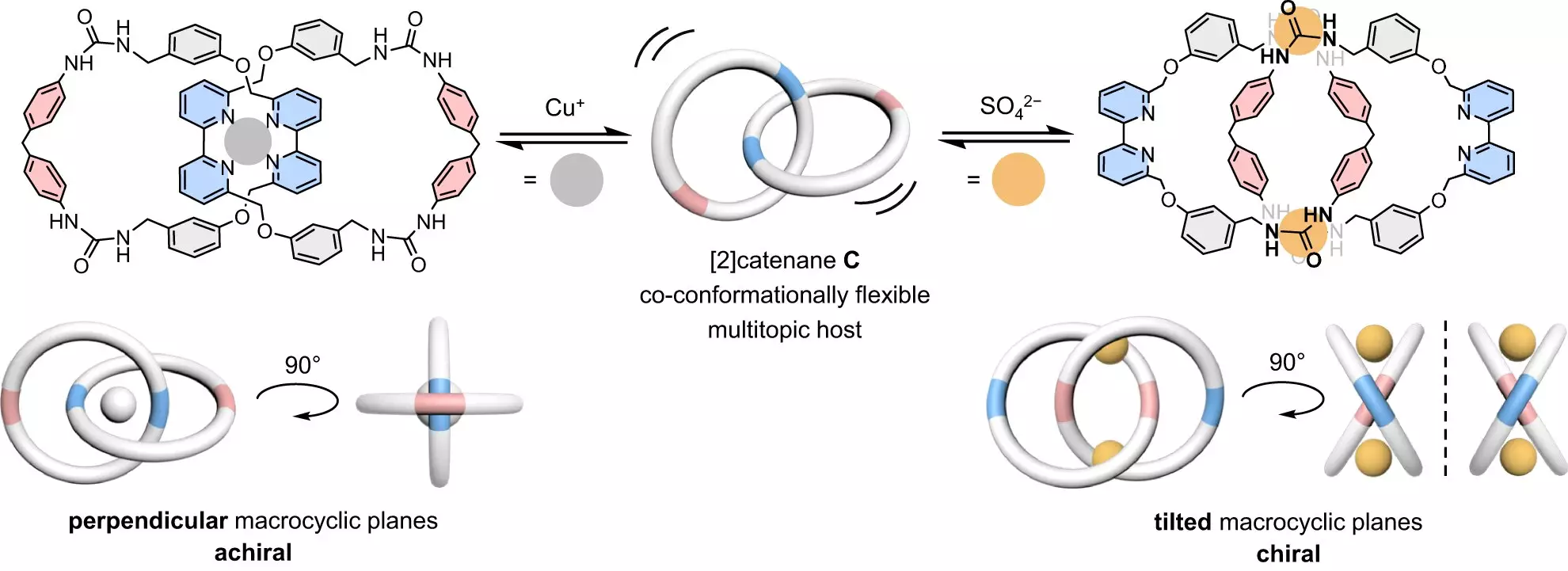In the realm of molecular science, an exciting frontier has emerged, showcasing the extraordinary capabilities of interlocked molecular structures known as catenanes. Much like everyday items such as metal chains or handcuffs, these molecular constructs combine rigidity with flexibility, enabling them to fulfill complex roles. Their pivotal dual nature—where hard, inflexible rings come together to form a system that demonstrates remarkable adaptability—positions catenanes as prime candidates for next-generation molecular applications, particularly in creating advanced molecular switches and machines.
However, the synthesis of catenanes has historically posed significant challenges. This intricacy has curtailed their exploration into broader realms beyond basic applications. Fortunately, recent breakthroughs at The University of Hong Kong, spearheaded by Professor Ho Yu Au-Yeung and his research team, shine a light on the potential of this intriguing molecular architecture. The synthesized catenane, featuring two freely rotating macrocycles, presents an extraordinary ability: it can selectively bind to both copper(I) cations and sulfate anions. This dual functionality is groundbreaking, considering the contrasting charges and geometries of these ions.
Unraveling the Complexity of Ion Binding
The scientific community has long grappled with the challenge of designing molecular hosts capable of interacting with both cations and anions. The fundamental principle of charge interaction dictates that like charges repel while opposite charges attract, complicating the creation of a dual-function host. Yet, Professor Au-Yeung’s innovative approach elegantly navigates this issue. By incorporating dedicated binding sites for both positively charged cations and negatively charged anions within the structure of the interlocked rings, the catenane displays a remarkable adaptability.
Utilizing its rotatory motions akin to a chameleon, the catenane adjusts its binding sites to correspond with the dynamic shapes and features of the ions it seeks to engage. This level of adaptability not only enhances the effectiveness of detection but could also lead to breakthroughs in environmental monitoring and medical diagnostics. The implications for environmental science are particularly noteworthy; copper(I) and sulfate are not only common pollutants but are also vital for biological processes. The capability to selectively extract and recycle these ions from samples brings forth new possibilities for sustainable practices.
Significant Implications for Health and Environment
As researchers delve into the intricacies of molecular binding, the potential applications of this technology expand into critical areas such as health and disease management. Just as blood tests routinely measure electrolytes to assess health, the development of advanced selective recognition technologies could transform diagnostic processes. Integrating catenanes into medical devices for ion detection could pave the way for more precise monitoring and therapeutic interventions for conditions associated with ionic imbalances.
Moreover, the environmental ramifications cannot be understated. With growing concerns regarding pollution and resource depletion, the capacity to extract essential ions from contaminated sources extends beyond mere academic interest; it represents a tangible method to address real-world problems. The design and synthesis of catenanes demonstrate that innovative molecular chemistry can lead to practical solutions that facilitate both environmental remediation and enhanced medical diagnostics.
The Road Ahead: Future Developments in Catenane Technology
Looking forward, Professor Au-Yeung’s vision does not rest with this singular breakthrough. The ongoing development of more sophisticated catenanes is on the horizon, aimed at achieving simultaneous binding of multiple ions or ion pairs. This advancement could revolutionize how we understand molecular interactions and the role of versatile structures in sophisticated chemical sensing.
The potential of catenanes resides not only in their current capabilities but also in the promise they hold for future innovations. As researchers continue to unlock the doors of molecular design, the emergence of catenanes as intelligent molecular receptors stands to shape the future of various scientific domains dramatically.
In essence, the bridge between macro-scale applications and nano-scale ingenuity is becoming increasingly apparent. The unique characteristics of catenanes depict a new era in molecular science—one where flexibility and strength coalesce to yield solutions that meet pressing environmental and health challenges. With innovative minds like Professor Au-Yeung at the helm, the future of molecular technology is indeed bright and filled with potential.


Leave a Reply